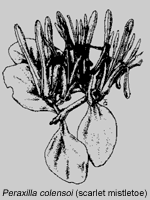| Our Environment: Issue 25 Summer 2000 |
Red- flowered mistloetoes add their own dash of Christmas cheer to South Island vegetation in December.
 New Zealand’s eight unique
mistletoe species include the red mistletoe (Peraxilla tetrapetala) which has bright red
flowers and insect galls or bumps on its leaves.
New Zealand’s eight unique
mistletoe species include the red mistletoe (Peraxilla tetrapetala) which has bright red
flowers and insect galls or bumps on its leaves.
The scarlet mistletoe (Peraxilla colensoi) is very similar but has larger leaves and
flowers.
Both are called beech mistletoes because they grow mainly in the southern beech forest.
Their explosive flowers are specially adapted to be opened by native birds such as bellbirds. The bird twists ripe buds with its beak and the petals spring open, showering the bird with pollen. The bird then delivers this pollen to the next flower it visits. Pollination produces fruits that are eaten by native birds which deposit the seeds on other suitable host trees.
Mistletoes use specialised roots to get water and nutrients from the host tree rather than the soil. Unlike many mistletoes in other countries, NZ varieties do not harm the trees they grow on. They help birds because they are one of the few plants in beech forests with available fruit and nectar.
Beech mistletoes, which also include the yellow mistletoe (Alepsis flavida), are increasingly threatened by introduced brushtail possums, which eat the leaves, flowers and fruits. The killing of native birds by predators such as stoats and rats is also a concern. Fewer birds means less pollination and dispersal of seeds. The Department of Conservation has introduced a comprehensive management programme aimed at simultaneously controlling many pests including possums, stoats and rats.
For more details see www.pams.canterbury.ac.nz.
Information provided by the Department of Conservation
| Our Environment Index |